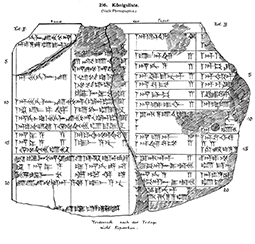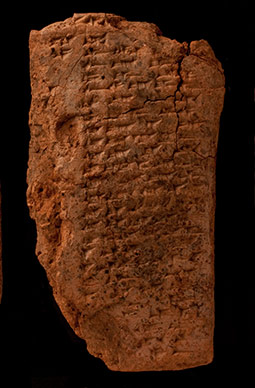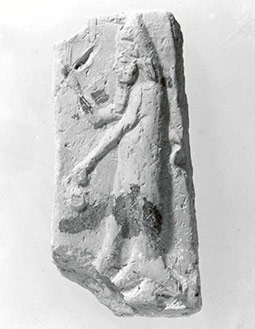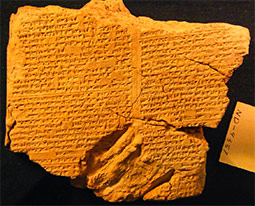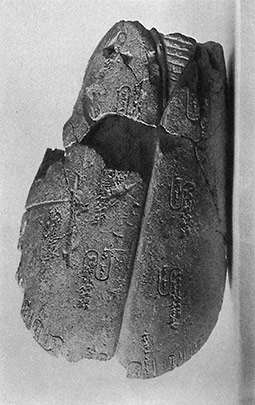Assyrian scholarly professions
Several different scholarly professions are attested at the royal court at Kalhu, in literary works, colophons, letters, administrative records and legal documents. The ummânu ("chief scribe") was the king's most trusted scholarly advisor. There were also diviners, healers, and lamenters.
The king's senior scholar
The Assyrian king appointed one particularly wise and trustworthy man to be his senior scholar TT . The literary term for this role was ummânu ("expert") but in more everyday contexts people used the phrases rab ṭupšarri ("chief scribe"), ṭupšar šarri ("king's scribe"), or variants on them.
The so-called Synchronistic King List (King List 12) aligns the names of Assyrian kings with their royal counterparts in Babylonia PGP (Image 1). From the early 9th century BC it also gives the names of each Assyrian ruler's ummânu. Unfortunately there is a large gap in the tablet TT but these are the names that survive:
- Gabbu-ilani-ereš PGP
- ummânu of Tukulti-Ninurta II PGP and Assurnasirpal II
- Meluhhaya PGP
- ummânu of Shalmaneser III
- (gap)
- Nabu-aplu-iddina PGP , Bel-upahhir PGP and Kalbu PGP
- ummânus of Sennacherib PGP
- Nabu-zeru-lešir PGP
- ummânu of Esarhaddon PGP
- Ištar-šumu-ereš PGP
- ummânu of Esarhaddon and Assurbanipal PGP
The father and son Nabu-zeru-lešir and Ištar-šumu-ereš are well known from 7th-century court letters and scholarly writings. They traced their ancestry back to Gabbu-ilani-ereš PGP , the very first Assyrian ummânu, who must have moved from Assur PGP to Kalhu with king Assurnasirpal II in the early 9th century. Although the court mainly met in Nineveh PGP by this time, the family still had close links to Kalhu.
However, the descendants of Gabbu-ilani-ereš did not have a monopoly on the position of ummânu. Colophons TT on scholarly tablets from Kalhu tell us that other men held that title at some periods of the 8th century BC:
- Marduk-[...] PGP , son of Babilayu PGP , descendant of Ištaran-šumu-ukin
- ṭupšar šarri ("king's scribe") and ummânu of Adad-nerari III PGP (r. 810-783 BC) (according to CTN 4: 8, written in 787 BC)
- Nabu-šallimšunu PGP , son of Harmakki
- ṭupšar šarri rabû ("king's senior scribe"), rab ṭupšarri ("chief scribe") and ummânu of Sargon II PGP in Kalhu. He was the author of the famous Letter to Aššur documenting Sargon's victory over Muṣaṣir in 714 BC, and also performed royal rituals TT in Assur that same year (2) (3).
- Nabu-zuqup-kenu PGP , descendant of Gabbu-ilani-ereš
- Nabu-zuqup-kenu himself modestly only uses the title ṭupšarru ("scribe") in his scholarly writings from the period 716-683 BC, at Kalhu and perhaps elsewhere. But he may have succeeded Nabu-šallimšunu as Sargon II's ummânu, helping to restablish the Gabbu-ilani-ereš family's claim to the title.
Scholars at court in 8th century Kalhu
About 30 ration lists of bread and wine found in Fort Shalmaneser (the so-called Nimrud Wine Lists TT ) date from the reigns of Adad-nerari III PGP and Tiglath-pileser III PGP . It is still disputed whether these texts represent regular allocations to court personnel and visiting dignitaries or extra distributions on special occasions. Either way, because they list the recipients in order of importance, they give us a glimpse into palace hierarchies in the 8th century BC.
On this evidence, perhaps surprisingly, it seems that the king did not hold his regular court scholars in particularly high regard (Image 2). Rather, he gave pride of place to the dāgil iṣṣūrī ("augurs" TT ), from Assyria's northwestern vassal TT and close ally Commagene PGP . These augurs divined the future from observing the flights of birds following a long-standing Syro-Anatolian PGP tradition. As Karen Radner argues, they were quite likely diplomatic visitors or long-term envoys and may have participated in an annual spring festival for the storm-god Adad PGP (4).
Local scholars came much further down the lists of bread and wine given out on such occasions, and were never named in person. The bārû-diviners TT - once or twice described as kaššaya ("Kassite" or Babylonian) - always preceeded the āšipu-healers and the asû-healers usually ranked bottom. Now and again, though, the rab asî ("chief asû-healer") headed the group of scholars.
- dāgil iṣṣūri-augurs, 784, 735?, 734? BC (CTN 1: 3, 8?, 9?, 14?, 16?, 29 (5))
- dāgil iṣṣūri kummuhaya, Commagene augurs, 784 BC (CTN 1: 3 = CTN 3 : 145 (6));
- bārû-diviners, c.780, 735 BC (CTN 1: 6, 8, 12, 13, 15, 16, 19, 20, 35; CTN 3: 120);
- bārû kaššaya, Babylonian diviners, c.780 BC (CTN 1: 30 = CTN 3: 120; CTN 1: 35)
- āšipu-healers, c.780, 735 BC (CTN 1: 6, 8, 13, 15, 16, 19, 35; CTN 3: 146);
- asû-healers, c.780, 735 BC (CTN 1: 8, 15; CTN 3: 122, 133, 139);
- rab asî, c.780 BC (CTN 1: 6, 19, 35).
āšipu-healers
The Assyrian word āšipu is often translated "exorcist" TT but this unhappy term does not capture the range and importance of this profession's work. As explained on the Knowledge and Power website, court āšipus in 7th century Nineveh PGP protected the king from harm through ritual purification, and helped to heal him in body and spirit (Image 3).
The profession of āšip šarri ("king's healer") is attested at Kalhu from the ninth to the seventh centuries BC. For the early period we have little more than names on scholarly tablets from the Ezida temple:
- Ištaran-mudammiq PGP
- who served Assurnasirpal II (CTN 4: 8, 58, 103)
- Nabu-mudammiq PGP
- Ištaran-mudammiq's son, c.850 BC (CTN 4: 8, 103, 247)
- Babilayu PGP
- Ištaran-mudammiq's grandson, c.820 (CTN 4: 8, 103?, 247)
These men were all descendants of Ištaran-šumu-ukin, that is, from the same family as Adad-nerari III's ummânu Marduk-[...]. To judge from the archaeological findspots TT of their tablets, these men were based at Nabu's temple, Ezida, in Kalhu.
This location continued to be closely linked to royal āšipus in the early 7th century BC. However, by that time, the Gabbu-ilani-ereš family had taken over. We have much more information about these men, not only from the colophons of their scholarly tablets but also from royal correspondence:
- Adad-šumu-uṣur PGP , āšip šarri, rab āšipī, šangamahhu of Esarhaddon
- This man was the son of Nabu-zuqup-kenu, descendant of Gabbu-ilani-ereš. He is attested in the reigns of Esarhaddon and Assurbanipal, last mentioned in 666 BC. At least some of Adad-šumu-uṣur's letters and astrological reports to his royal masters were sent from Kalhu (SAA 8: 160–163; SAA 10: 185-232). He deposited scholarly works in Ezida (CTN 4: 45, 74?, 78?, 89?) and performed ritual TT measures against fungus in that temple (SAA 13: 71).
- Šumaya PGP , āšipu of Esarhaddon
- Šumaya was Adad-šumu-uṣur's nephew. He requested permission from crown prince TT Assurbanipal to inherit his dead father Nabu-šumu-lešir's position in Kalhu (SAA 16: 34) and may have copied scholarly tablets for Ezida (CTN 4: 59?, 74?, 78?, 89?).
- Banunu PGP , āšipu
- This man, of unknown family, copied scholarly works for Ezida in the 7th century (CTN 4: 61, 116, 185?, 188, 192).
- Marduk-šakin-šumi PGP , rab āšipī
- Adad-šumu-uṣur's successor consulted tablets in Kalhu in preparation for a ritual with the queen mother TT (SAA 10: 245-246) and recommended that an apotropaic TT ritual to be performed in Kalhu as well as Nineveh (SAA 10: 240, 271).
- Nabu-nadin-šumi PGP , āšipu
- He apologises to Esarhaddon that he has been uncontactable in Kalhu (SAA 10: 228).
asû-healers
The asû-healers worked closely with their āšipu colleagues, at least in the Assyrian court of 7th century Nineveh. We don't know much about their activities at Kalhu, and they don't seem to have been associated with Nabu's temple there (they were by and large secular). But three are mentioned by name in early 8th century administrative documents:
- Nabu-šumu-ibni PGP , asû
- Witness in a legal document, 797 BC (CTN 2 (7): 51)
- Bur-Zinani PGP , asû
- Acts as a witness in a legal document from the Governor's Palace; receives wine rations, 784?, 779 BC (CTN 2: 68; CTN 1 (8): 2 = CTN 3 (9): 145; CTN 1: 3; 18)
- Birtayu PGP , asû of the chief eunuch TT
- Witness in the legal document of a bārû, 783 BC (CTN 2: 17)
ṭupšar Enūma Anu Ellil experts
The profession known as ṭupšar Enūma Anu Ellil (literally "scribes of the celestial TT omen TT series When the gods Anu Ellil (and Ea) TT ") are often described as astrologers TT (Image 4). We should be wary of this designation, though. They did not cast horoscopes (and could not have done, centuries before the invention of the zodiac). Nor were they concerned only with the night sky. Rather, they read the gods' intentions for the Assyrian empire through observing ominous events in the heavens and on the earth, as described on the Knowledge and Power website.
We know of no ṭupšar Enūma Anu Ellil active at Kalhu in the 9th or 8th centuries BC. In the 7th century (when we have the richest evidence), kings Esarhaddon and Assurbanipal received reports from many central Assyrian and northern Babylonian cities. Many of the men who sent these omen reports to the king were also engaged in other scholarly activities. It is likely, then, that ṭupšar Enūma Anu Ellil was not a primary professional designation but a secondary role that scholars played.
- Baba-šumu-iddina PGP
- This man wrote twice to Assurbanipal that he had observed a lunar eclipse on a cloudy night (SAA 10: 134–135).
- Possibly relating to the same incident, the king was urged that a report from Kalhu should be checked in Assur and Arbela PGP (SAA 10: 151).
bārû-diviners
The primary role of the bārû was to confirm or refute the advice, rumours and prophecies that reached the ear of the king. This profession worked in teams, isolated from other members of court who might influence them, to perform sacrificial divination, as described on the Knowledge and Power website. They asked the gods a yes-no question on behalf of the king, as part of a ritual performed in a public space in the palace, then helped him to make sense of the answer that was inscribed in the entrails of a sacrificed animal (Image 5).
We know the name of only one bārû in early 8th century Kalhu:
- Samuti PGP , bāri šarri ("king's diviner") of Adad-nerari III
- This man buys land from a eunuch, as recorded in a legal documented witnessed by the chief eunuch's asû, 783 BC (CTN 2 (10): 17)
However, as we have seen from the Nimrud Wine Lists, both Assyrian and Babylonian bārûs were allocated wine for court feasts at that time.
In the early 7th century BC, Esarhaddon had some bārûtu-divinations carried out at Kalhu (SAA 4: 122, 183).
No works of bārûtu - the art of the diviner - survive in the Kalhu Ezida. Given their professional segregation it is unlikely that bārû-diviners were ever closely involved with Nabu's temple.
kalû-lamenters
The lamenter's role was to respond to negative omens or other divine messages, through ritual acts of penitence on behalf of the king. They often worked in collaboration with āšipus and ṭupšar Enūma Anu Ellil, at least in 7th century Nineveh. We don't know much about their activities in Kalhu, however, because as temple personnel, they came to the king's attention only when they were misbehaving.
Lamenters were not part of the courtly retinue that received wine rations in the 8th century BC. Nor, so far as we know, did they write scholarly tablets for Ezida — unless we count Nabu-leʾi PGP (professional title unknown), son of the lamenter Urad-Ea PGP (CTN 4: 187).
- Pulu PGP , kalû
- He worked in Ezida in the early 7th century, reporting to the king that a sheep slaughtered there for sacrifice had defective (and therefore potentially ominous) kidneys (SAA 10: 131, 133). However, the bārû did not normally consider the kidneys to be ominous organs. A colleague (whose name is now lost) complained at great length to the king about the liberties Pulu was taking in the conduct of the Ezida's cult (SAA 10: 134).
- Nabu-eriba PGP , kalû
- All was not well in Ninurta's temple either. Its šangû-priest, Aššur-reṣuwa PGP , complained to the king that Nabu-eriba had been stealing precious metals from its decor, in cahoots with the temple guard (SAA 13: 128).
raggim(t)u-prophet(esse)s
Prophets TT (literally "shouters") received ecstatic TT revelations from the gods that were reported to the king. Uneducated, non-elite, and mostly female, they were outside the scholarly system. Diviners could be asked to check the veracity of their claims. Most surviving Assyrian prophecies are from women associated with the goddess Ištar's temple in Arbela, including one for Esarhaddon by Urkittu-šarrat PGP , who was originally from Kalhu (SAA 9: 2).
Content last modified: 18 Dec 2019.
References
- , pp. 116–21. (Find in text ^)
- Mayer, W., 1983. "Sargons Feldzug gegen Urartu - 714 v.Chr. Text und Übersetzung", Mitteilungen der Deutschen Orient-Gesellschaft 115, pp. 65-132. (Find in text ^)
- Driel, G. van, 1969. The Cult of Aššur (Studia Semitica Neerlandica 13), Assen: Van Gorum, pp. 198-205. (Find in text ^)
- Radner, K., 2009. "The Assyrian king and his scholars: the Syro-Anatolian and the Egyptian schools", in M. Luukko, S. Svärd and R. Mattila (eds.), Of God(s), Trees, Kings, and Scholars: Neo-Assyrian and Related Studies in Honour of Simo Parpola (Studia Orientalia 106), Helsinki: Finnish Oriental Society, pp. 221-238 (free PDF from Assyrian Empire Builders, 2.1 MB), pp. 231–233. (Find in text ^)
- Kinnier Wilson, J.V., 1972. The Nimrud Wine Lists (Cuneiform Texts from Nimrud 1), London: British School of Archaeology in Iraq (free PDF from BISI, 113 MB). (Find in text ^)
- Dalley, S.M. and J.N. Postgate, 1984. The Tablets from Fort Shalmaneser (Cuneiform Texts from Nimrud 3), London: British School of Archaeology in Iraq (free PDF from BISI, 123 MB). (Find in text ^)
- Postgate, J.N., 1973. The Governor's Palace Archive (Cuneiform Texts from Nimrud 2), London: British School of Archaeology in Iraq (free PDF from BISI, 175 MB). (Find in text ^)
- Kinnier Wilson, J.V., 1972. The Nimrud Wine Lists (Cuneiform Texts from Nimrud 1), London: British School of Archaeology in Iraq (free PDF from BISI, 113 MB). (Find in text ^)
- Dalley, S.M. and J.N. Postgate, 1984. The Tablets from Fort Shalmaneser (Cuneiform Texts from Nimrud 3), London: British School of Archaeology in Iraq (free PDF from BISI, 123 MB). (Find in text ^)
- Postgate, J.N., 1973. The Governor's Palace Archive (Cuneiform Texts from Nimrud 2), London: British School of Archaeology in Iraq (free PDF from BISI, 175 MB). (Find in text ^)
Eleanor Robson
Eleanor Robson, 'Assyrian scholarly professions', Nimrud: Materialities of Assyrian Knowledge Production, The Nimrud Project at Oracc.org, 2019 [http://oracc.museum.upenn.edu/nimrud/ancientkalhu/thepeople/professions/]
